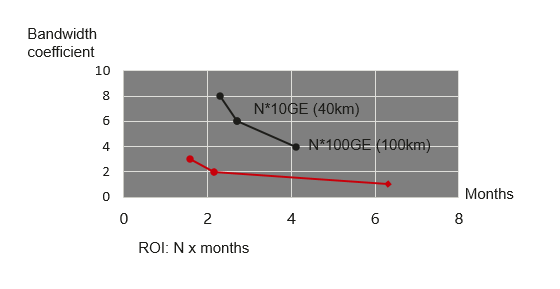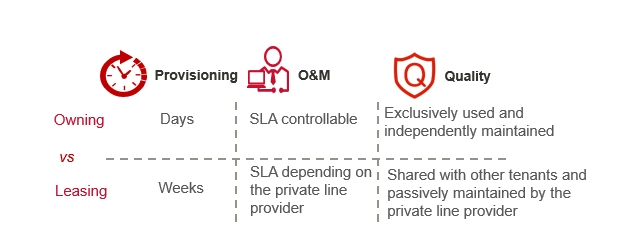Este sitio utiliza cookies. Si continúa navegando en este sitio, acepta nuestro uso de cookies. Lea nuestra política de privacidad>
![]()
Este sitio utiliza cookies. Si continúa navegando en este sitio, acepta nuestro uso de cookies. Lea nuestra política de privacidad>
![]()
Productos, soluciones y servicios empresariales
Just as steam engines, generators, computers, and the Internet revolutionized society before, new 5G, AI, and cloud-driven technologies are doing the same. Global enterprises are well aware of the significance of these technologies, in turn driving a new round of transformation in industry.
Data Centers (DCs) stand as the key, if 5G, cloud computing, and AI are to take off. This has resulted in industries across the globe expanding their existing DCs as well as constructing new ones. Indeed, more and more large-size enterprises, financial institutions, and government agencies have grasped the initiative and begun to build their own DCI networks. Similar to the importance of the bus in computing, DCI is the core infrastructure of the cloud computing era, and has consequently become a focal point of cloud construction, due to its high bandwidth and quality requirements. This has led to a dilemma: should you lease or build your own DCI? To answer this, we need to first consider cost effectiveness, bandwidth, security, and stability.
Previously, although DCI bandwidth reached the gigabit level, data volume remained surprisingly low. At that time, it was difficult to find fiber resources, and network transmission devices were complicated, requiring professional engineers for O&M. As a result, most companies felt it was more feasible to lease private lines for DCI. But now, DCI bandwidth has experienced a sharp increase, reaching the 10G level, and the digital economy is driving optical fiber deployment in many industries (particularly, the power and energy sectors). It is now easier to access fiber resources, while technological advances have lowered the per bit cost of transmission devices. IT-style DCI devices are more O&M friendly and, compared to traditional CT-oriented telecom transmission devices, are significantly simplified, with reduced OPEX. Therefore, considering the technological readiness and easier fiber resource accessibility, the time is now right for enterprises to build their own DCI networks.
Leased private lines are charged on a monthly basis, based on bandwidth, with varying pricing levels. However, generally speaking, 10G/100G WDM-based private lines are more expensive than IP-based MPLS private lines. If you build your own DCI, the cost includes the initial equipment needed, fiber leasing cost, and subsequent OPEX, such as equipment O&M, electricity, and equipment room leasing.
The following table compares the price of leasing a private line in a European city with the cost of a self-built DCI.
Private line leasing cost
|
Private Line |
Monthly Fee (US$) |
|
1 x 10 GE |
2500 |
|
1 x 100 GE |
20,000 |
Self-built DCI cost = Equipment CAPEX + Optical fiber leasing + OPEX (space leasing/electricity fee/O&M)
|
Self-Built DCI |
Monthly Fee (US$) |
One-Off Fee (US$) |
|
Fiber leasing |
100/km |
|
|
Equipment CAPEX |
XXXXX |
|
|
OPEX |
XXXX (amortized) |
|
According to this calculation, if DCI bandwidth is 4 x 10 GE @ 40 km, the cost of a self-built DCI can reach parity with the cost of a leased private line in approximately five months. And in the case of 2 x 100 GE @ 100 km, parity is reached within three months. Of course, actual costs may vary, but in most cases, the cost of a self-built DCI will be the same as a leased private line faster when the bandwidth is higher.


Higher Service Provisioning Efficiency: Private line provisioning depends on the efficiency of network service providers. Self-built DCI is more time-effective.
In the Internet era, the requirements for efficient service rollout are increasing. If DCI deployment is slow, the overall service commissioning and rollout will be subsequently delayed. The networks that carry private lines from network service providers are usually designed for wide coverage, rather than for specific applications or customers. If bandwidth or latency cannot meet requirements for DCI application, network capacity needs to be expanded or new links added. This normally involves complex procurement and deployment processes as well as the complex provisioning and commissioning of CT equipment, potentially slowing down private line provisioning to several weeks or even months. Self-built DCI does not require the processes and technologies of network service providers, and therefore the SLA and deployment timeframe can be customized. IT-style DCI devices that are more suitable for DC deployment can be selected for easy deployment, and services can be provisioned within several days. Once the initial network is built, future service provisioning based on network expansion will be more efficient and can be completed within several hours.
Higher O&M Efficiency: Passive response to private line O&M is slow, self-built DCI is more controllable, achieving efficient O&M.
The O&M management process of network service providers is complex. This is because network service providers need to determine whether the fault exists on private lines by means of fault demarcation, then locate the fault on a large private line network composed of many CT devices. This process may involve multi-level O&M departments. If network service providers lack the necessary O&M capabilities, they must seek help from device vendors. Before network service providers can implement O&M, they need to evaluate the impact this will have on other tenants and services running on the same network, possibly leading to inefficient O&M. However, network O&M is completely under your control when building your own DCI. Maintenance for DCI can be provided by a contracted vendor, which is more flexible and faster than typical network service providers. Furthermore, smaller DCI networks are easier to troubleshoot than the larger networks of private line providers.
Better Quality Assurance: Private line are not dedicated networks. Network adjustment affects the quality. Self-built DCI is a physical dedicated network, which ensures the quality.
A private line network is usually shared by B2B, B2C, and home services, and even a dedicated private line network is shared among multiple tenants and services. Frequent capacity expansion and network adjustment can severely impact service stability, latency, and security. Once the service adjustment of a private line involves link expansion or cutover, approval from different tenants is normally required, resulting in low efficiency. Private line tenants can only see the service ports allocated to them, with the transmission path of the service controlled by the network service provider. In order to maximize the overall resource utilization of its network, a service carried by a private line may unnecessarily pass through multiple network paths, which makes the service path more complex. In this way, the service is easily affected by network fluctuations and adjustments, and even service interruptions caused by O&M personnel errors of the network service provider. Therefore, leased DCI is prone to errors, which can lead to lower availability. In contrast, as a physical private network, self-built DCI network provides exclusive optical fiber and devices, avoiding unwanted network adjustment and ensuring higher transmission quality.